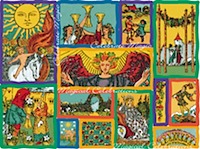By Jeanne Fiorini
Here in the fine state of Maine, no time of year elicits such a keen awareness of the changing seasons as do the first weeks of autumn. Nature transforms balmy days into crisp ones, forcing leaves from their summer homes and urging spring’s plantings through the final days of their lifecycles. In similar fashion, people abandon their expansive summer schedules and return to school and work, reorienting themselves to whatever they consider to be “life as usual.” How appropriate, then, that in this season of adjustment, Libra the Mediator presides.
The autumnal equinox, that point in time where the light and dark of day and night are in equal relationship to each other, occurs at the beginning of the Libran phase. Libra is the midpoint of the zodiacal cycle as well as being a balancing point between gentle Virgo and intense Scorpio. What transition could not benefit from the presence of a force that can maintain all these possibilities and not be torn apart by the tension?
It is no surprise that those folks born under the sign of Libra are capable of holding disparate energies simultaneously. This is in part why Librans are often accused of waffling; they can actually see both sides of a story at the same time. How aggravating!
A valuable attribute of Librans is that they are adept at expressing harmony and diplomacy. They possess faculties of impersonal logic and detached observation, and will be brutally honest in their evaluation. A Libran can be both fair and harshly critical, a social butterfly and yet reservedly independent, touchingly sentimental while simultaneously being capable of lopping your head off with a single word. Librans are as friendly and likeable as they come, but can be fierce in their defense of independent thinking and matters of social justice. As the strongest representative of Libran energy in the Tarot, the Justice card holds this same power and ambiguity.
In the traditional RWS deck, Justice is Major Arcana Card “11,” this number placement itself expressing the dual nature of Libra. (The number “11” is comprised of two “ones” standing side by side; also note that “one” plus “one” equals “two.”) In the same way that within a single week we can experience autumn days reminiscent of summer and others that feel like late November, the wide range of possibilities contained in the Justice card can make it a particularly difficult card to interpret. (It may be interesting to note that the word “double” and the word “doubt” come from the same etymological root.)
Using a hypothetical example, let’s say that the Justice card is drawn in response to the question, “What can I do about the unsatisfactory state of my family life?” We could be looking at very different interpretations depending on one’s perspective:
1. Justice seen as a card of fairness and harmony encourages one to do whatever imparts peace to the situation. “Balance one’s own needs with those of the system. Pay attention to what will be good for the family as a whole, and create a compromise that will keep everyone happy. Use words diplomatically to achieve cooperation. See the big picture and make sure all persons’ needs are taken into consideration. Be the Jimmy Carter of the situation."
2. Justice seen as a card of objective mental clarity requires that one rely on the bare facts to make the best decisions. “Emotional arguments are to be avoided since the needs of the heart are antithetical to obvious rational solutions. Be independent and logical in how one presents a case, because the voice of individual truth needs to be heard. Be clear about what’s OK and what’s not OK. Stand up for oneself; be straightforward and assertive. Be the Judge Judy of the situation.”
Scenario #1 maintains community values and harmony; Scenario #2 supports the unique needs of the individual and their bottom-line truths. It’s unlikely that both camps can readily be accommodated, so what can we do here? As querents - and as readers - we have options in situations such as these:
1. Consider which course of action is supported by intuition. The felt sense of the Justice card– or any other card in a reading for that matter- is a good barometer for which direction the sword wants to swing.
2. Can drawing other “helper” cards clarify the best course? Asking questions such as “What else do I need to know about this situation?” or “What should I pay attention to in order to make the best decision?” can provide useful information when the initial cards don’t give us a complete picture. Receiving cards of cooperation (such as the Three of Pentacles, The Hierophant, or Six of Swords for instance) would lean us toward Scenario #1; cards of assertion or independence (perhaps the Ace of Wands, Nine of Pentacles, or the Five of Swords) would push us toward Scenario #2.
3. See if there is a possibility of attaining a “both/and” solution rather than “either/or.” This is the most difficult option, but surely the most Libran solution of all.
In the same way that Libra mediates between the hot dryness of summer and the damp coolness of impending winter, Justice holds the many different versions of the truth and the space between them. And whichever direction it eventually swings, the sword of Justice will assert its truth, decisively and without apology.
The Justice card carries with it, then, an awesome responsibility: the responsibility to take the time to weigh the facts, to listen to and consider all sides of a dilemma, and to deal honestly and directly with the ramifications of one’s determination. Most importantly it carries the responsibility of knowing one’s own heart and mind so that words and actions ring true when the sword is wielded. Let us take care with how we use our sense of Justice, because like a bad hair-do, a thing is difficult to repair once it’s been cut.

